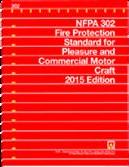PATH: Home » Contents > Boat Building » Statutes & Standards > NFPA >
CONTENTS
1 – NFPA Introduction
2 – NFPA 302 Introduction
2.1 – What is NFPA 302?
2.2 – What does NFPA 302 address?
3 – NFPA 302 Table of Contents
4 – NFPA Free Access to Codes & Standards Widget
5 – NFPA Contact Information
The National Fire Protection Association (NFPA) is a United States trade association, albeit with some international members, that creates and maintains private, copyrighted, standards and codes for usage and adoption by local governments. This includes publications from building codes to the many on equipment utilized by firefighters while engaging in hazardous material (hazmat) response, rescue response, and some firefighting.
Fire Protection Standard for Pleasure and Commercial Motor Craft
NFPA® 302 – 2015 Edition
What is NFPA 302?
This standard provides fire and life safety requirements for boats (less than 300 gross tons) that are used for pleasure and commercial purposes.
What does NFPA 302 address?
Provisions apply to (1) elimination of ignition sources, (2) ventilation of accommodation spaces, fuel tank compartments, and machinery spaces, (3) use of combustible materials, (4) fire-extinguishing equipment and fire exits, (5) control of fire-extinguishing agents in machinery spaces, and (6) mitigation of carbon monoxide hazards. Specific criteria cover hull, engines and engine exhaust systems, cooking and heating appliances, electrical systems, lightning and fire protection, and carbon monoxide detection.
Table of Contents
Chapter 1 – Administration
1.1 Scope
1.2 Purpose
1.3 Application
1.4 Retroactivity
1.5 Equivalency
1.6 Units
Chapter 2 – Referenced Publications
2.1 General
2.2 NFPA Publications
2.3 Other Publications
2.4 References for Extracts in Mandatory Sections
Chapter 3 – Definitions
3.1 General
3.2 NFPA Official Definitions
3.3 General Definitions
Chapter 4 – Hull
4.1 General Arrangement
4.2 Spaces Open to the Atmosphere
4.3 Natural Ventilation
4.4 Connecting Compartments or Spaces by a Natural Ventilation System
4.5 Powered Ventilation System
4.6 Arrangements of Openings
4.7 Combustion Air
Chapter 5 – Engines
5.1 Exposed Engine Surface Temperatures
5.2 Diaphragm-Type Gasoline Pumps
5.3 Marine Carburetors
5.4 Electrical Components
5.5 Air-Cooled Engines
5.6 Portable Gasoline Tanks
5.7 Automatic Shutdown
5.8 High-Tension Cable
5.9 Distributors
Chapter 6 – Engine Exhaust Systems
6.1 General Requirements
6.2 Materials
6.3 Hose Connections
6.4 Temperature Protection
Chapter 7 – Fuel Systems
7.1 General Requirements
7.2 Fuel Tank Materials
7.3 Fuel Tank Design and Construction
7.4 Fuel Tank Installation
7.5 Fuel Lines, Fittings, and Related Accessories
Chapter 8 – Cooking, Heating, and Auxiliary Appliances
8.1 General
8.2 Cooking Appliance Installation
8.3 Coal, Charcoal, and Wood-Burning Appliances
8.4 Liquid Fuel Appliances Excluding Liquefied Petroleum Gas (LPG) Appliances
8.5 LPG and CNG Systems for Permanently Installed Appliances
8.6 Service Water Heating Units and Cabin Heaters
8.7 Lamps
8.8 Electric Stoves
8.9 Portable Electric Heaters
8.10 Portable Dehumidifiers
Chapter 9 – Electrical Systems Under 50 Volts
9.1 Scope
9.2 General Requirements
9.3 Batteries
9.4 Power Distribution System Negative Connections
9.5 Continuously Energized Parts
9.6 Marking
9.7 Ambient Temperature
9.8 Ignition Sources
9.9 Overcurrent Protection
9.10 Switches
9.11 Appliances and Equipment
9.12 System Wiring
9.13 Wiring Installation
9.14 Wiring Connections
9.15 Receptacles
9.16 Plug Connectors
Chapter 10 – Alternating Current (AC) Electrical Systems on Boats
10.1 Scope
10.2 General Requirements
10.3 Marking
10.4 System Voltage
10.5 Ambient Temperature
10.6 Ignition Source
10.7 Shore Power Polarity Devices
10.8 Overcurrent Protection
10.9 Main Supply
10.10 Branch Circuits
10.11 Ground-Fault Circuit Interrupters (GFCIs)
10.12 Appliances and Equipment
10.13 Conductors and Flexible Cords
10.14 Installation
10.15 Receptacles
10.16 Main Panelboard
10.17 Alternating-Current (ac) Generators
10.18 Isolation of Galvanic Currents
10.19 Shore Power
10.20 Application of Types of Shore Power Circuits
Chapter 11 – Lightning Protection
11.1 General
Chapter 12 – Fire Protection Equipment
12.1 Fire Suppression Equipment
Chapter 13 – Carbon Monoxide and Smoke Detection
13.1 Carbon Monoxide and Smoke Detection Systems
13.2 Installation
13.3 Smoke Detection
Annex A – Explanatory Material
Annex B – Portable Fire Extinguishers and Fixed Systems
Annex C – Operation and Maintenance
Annex D – Fire Warning Equipment
Annex E – Extinguisher Inspection and Maintenance Information from NFPA Standards
Annex F – Informational References
Index
NFPA 302 page at NFPA: http://catalog.nfpa.org/2015-NFPA-302-Fire-Protection-Standard-for-Pleasure-and-Commercial-Motor-Craft-P1279.aspx
Relevent parts of this standard are explained in AEABoats’ Do-It-Yourself Inspections articles,
DIY Refitting and Repair articles, Havórn Marine Survey and Shipwright School courses, and Anchors Aweigh Academy‘s online Marine Surveying Course.

Even though NFPA owns those copyrights, they have offered free access to all of their codes and standards on their web site for more than 10 years through a read-only site. Documents cannot be downloaded or printed, because they rely on the revenues from people who want to own their own copies to fund the mission of NFPA. But for users who need to familiarize themselves with a code or check a requirement, this kind of access is invaluable. CLICK the above NFPA Logo for free access to all NFPA Codes and Standards.
If you would like to ADD the NFPA FREE ACCESS Widget like the one above to your website, CLICK HERE to go to the “NFPA FREE ACCESS WIDGET” webpage and follow the directions.
Contact Information
National Fire Protection Association
1 Batterymarch Park
Quincy, MA 02169-7471, USA
Telephone: (617) 770-3000
Fax Line: (617) 770-0700
Call Toll-Free from Mexico: 95-800-844-6058
Webesite: www.nfpa.org
Contact Info: www.nfpa.org/about-nfpa/contact-us

